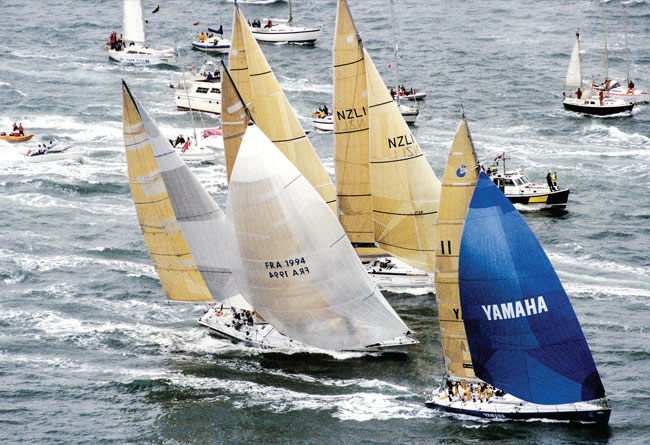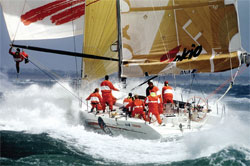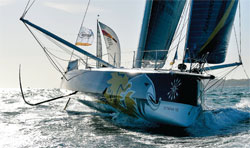

James Boyd has been digesting the context to the sweeping changes that are now confirmed for the next Volvo Ocean Race 2019
With the announcement of its as yet unchristened new, foil-assisted monohulls for the 2019-20 crewed lap of the planet, and beyond, the Volvo Ocean Race continues its longstanding tradition of letting the Imoca class do much of its full-scale R&D. But has it all happened too fast this time?
Water ballast was first introduced in the Whitbread 60s for the 1993-94 race having been used on the Imoca 60s’ forebears, the Open 60s, from the early 1980s. VO70s made their Volvo race debut in 2005 with canting keels, some 12 years after Isabelle Autissier’s Ecureuil Poitou Charentes 2 became the first Open 60 to use one (and several more years after Michel Desjoyeaux – inevitably – had introduced the canting keel to the Mini 6.50 fleet).
In comparison the latest change has been much swifter, the first foil-assisted Imoca 60s launched barely two years ago with the first foil-borne Volvo boats following just four years later.
What must be of some concern is that, compared to water ballast and canting keels, foiling technology is way more complex and tricky to engineer in an offshore environment. For example, of the five newgeneration semi-foiling Imoca 60s on their first major outing in the 2015 Transat Jacques Vabre, only Banque Populaire finished (with structural damage), while others suffered severe failures, the worst being Hugo Boss which was nearly written off.
In last winter’s Vendée Globe five of the seven foilers finished, with Alex Thomson famously breaking one of Hugo Boss’s boards. Upon finishing, race winner Armel le Cléac’h admitted that he had been cautious about using Banque Populaire’s foils: ‘I tended to use them [only] in situations where I thought I needed to boost my speed, like a turbo, when I needed to attack a little more.’ But this may also have been to avoid repeating the same damage that sistership Edmond de Rothschild sustained to the top of her port foil, which partially broke within its case leaving it, as skipper Seb Josse alarmingly reported, ‘just hanging by two screws’.
Before it was finally rubber-stamped by the class in the build-up to the last Vendée Globe there was a lobby in Imoca arguing that the new foil technology would be both expensive and also premature, as the class was at the time more focused on improving reliability with one-design masts and keels.
This was highlighted at the Mini Transat start in 2015, when the president of Classe Mini said they were looking to the Imoca 60s to see how the new foil technology fared before deciding whether they would allow it on their 21-footers!
Isn’t R&D work usually carried out on smaller boats first? In fact, Banque Populaire had done exactly this – testing newgeneration lifting foils on a Mini for R&D purposes before building the foils for their latest 60-footer.

This may be one reason why their boat suffered the least structural issues when it went on to win the Vendée Globe. Meanwhile, Classe Mini has relaxed its rule, now allowing lifting foils that extend beyond their 3m Bmax limit.
Of course, fitting foils to boats, be they monohulls or multihulls, is very desirable, being one of the most significant performance developments in the history of yachting. Trying to restrain its development is like trying to hold back the tide. But be warned… In the build-up to the 35th America’s Cup, teams broke very many expensive foils and they had working for them some of the best hydro and engineering talent money can buy (fortunately Guillaume Verdier, designer of the new Volvo boat, works for Emirates Team New Zealand which allegedly didn’t break any).
Foil developments, both for multihulls and monohulls, are at present mostly occurring within the constraints of rules. So, for example, the AC72 rule didn’t permit any part of a daggerboard to extend beyond the ‘yacht’s’ 14m maximum beam. As a result – although this was probably good for safety – AC72 daggerboard tips all point inboard.
This configuration was further tightened with the ‘box’ rule for the AC50 daggerboards, although this permits boards to exceed BMax to a limited degree above deck. The flying cats of the America’s Cup in San Francisco spawned a number of smaller new one-designs or retrofitted boats, from the GC32 and Flying Phantom to the new flying Nacra 17 Olympic catamaran, all featuring AC72/50-style daggerboards.
A tour of the boatpark at Weymouth Speed Week or Foiling Week in Garda shows that there are plenty of other configurations that will readily get a boat flying, for example L-foils with the tips pointing outboard, only they aren’t the fashion. But, in particular, they haven’t benefited from the gazillions spent on R&D covering every aspect that the foils created in Cup-land have been given.
Similarly in the monohull world foil development has been driven by the Imoca 60s, but also by Dynamic Stability Systems. DSS foils, when they were first unveiled more than a decade ago, were designed principally to provide lift to leeward in a pleasing Newtonian kind of way: on a DSS-equipped boat an increase in wind is translated more efficiently into extra speed as the faster the boat goes the more lift and righting moment the DSS foil generate (hence the ‘D’ in DSS). So, unlike a conventional keelboat, a DSS yacht, thanks to its foil, gains stability the faster it goes.
DSS foils have since evolved and are now capable of getting boats fully airborne or at least airborne to a much greater degree than witnessed to date in the Imoca 60 fleet. They are used on the award-winning Hugh Welbourn-designed Quant 23 scow and the 747 SEAir Mini (issue 448).
While DSS foils were born without consideration of rules (although they have since caused the RORC rating office much head-scratching), this was not the case for Imoca 60 foils.
Imoca foils aren’t limited by beam restrictions (in fact, BMax of 5.85m for the hull was only introduced prior to the last race), but Imoca 60s are limited to a maximum of ‘only’ five appendages.
Imoca 60s have twin rudders to reduce drag and provide neutral helm to reduce autopilot power consumption; with a canting keel it is then necessary to have something in the water to prevent leeway and while a few early boats had a single central daggerboard more usually twin asymmetric daggerboards are fitted.
Early daggerboards on canting-keel Imoca 60s were typically toed out, like the twin rudders, with the aim of being vertical when heeled. The 2004 Farr-designed Virbac-Paprec was fitted with boards that were vertical in the boat and inclined when heeled, providing some vertical lift. By the 2012 Vendée Globe this had developed on Banque Populaire and François Gabart’s race winner Macif to boards that were ‘toed in’ and mounted well outboard, penetrating the deck close to the gunwale and developing even more vertical lift.
But the foils fitted to the last-generation Imoca 60s represented a quantum leap in vertical lift, causing a dramatic reduction in wetted surface area and, occasionally in stronger winds, boats to get airborne.
However, a downside of the new foils (apart from mooring them side-to) is that the prevention of leeway has become secondary. According to skipper Séb Josse, the area of Edmond de Rothschild’s Dali foils used to counter leeway is 1.8m2, compared to around 4m2 for a conventional daggerboard. Not surprisingly, last-generation Imoca 60s are not weapons upwind.
The Imoca 60 five-appendage limit also hasn’t helped. While going for a one-design keel and mast package improved reliability, it didn’t reduce costs; for the larger teams building new boats budgets increased this time by around 30 per cent (a foiling Imoca 60 will leave you little or no change out of 5 million euros).
A suggested solution was to change the Imoca 60 rule to permit seven boards, including two pairs of daggerboards. This would solve upwind performance as one set of boards could be dedicated to preventing leeway leaving the other to provide vertical lift. This would also reduce costs as two pairs of straight (or straighter) daggerboards will cost less than constructing a single pair of Dali boards with a giant, complex, expensive to build and possibly unreliable right angle in them. However, the result of a seven-appendage ‘Swiss army knife’ would be an unwelcome weight penalty of around 200kg.
Another solution to the upwind problem, which seems to have been deliberately kept in the Imoca 60 rule hoping that someone, someday, will take advantage of it, is to go for a narrower boat with a fixed keel relying on a foil to leeward to provide more of its stability. This would involve the keel foil itself preventing leeway – a radical concept, eh? – while allowing a lateral foil the sole job of producing vertical lift, to compensate for lost righting moment due to the lack of canting keel and hull form stability, as well as helping this smaller, lighter (and potentially cheaper) boat to get fully airborne.
An added benefit is that to assist upwind ability on our 60ft cigar the Imoca 60 rule still allows a fixed-keel boat to have a trim tab. The only problem is that no one is likely to take this option now that new Imoca 60s are locked into having a onedesign keel and mast.
However, perhaps this might be a more suitable solution for the new Volvo onedesigns: a foiling boat that requires much better windward ability than an Imoca 60. The new Figaro, for example, gets around this by having a fixed keel.
Guillaume Verdier is well aware of the need for the new Volvo boat to have better upwind performance, but says ‘the secondgeneration foils from the last Vendée Globe were a huge jump on from the first generation, so we should be able to do something fine for upwind.’ He adds that they will also look to redistribute the areas between the appendages and will have a deeper keel… and possibly even a trim tab.
According to Verdier the only part of the new Volvo one-design to have been fixed to date is the length, but it sounds like the new boat may be an Imoca 60 on steroids, with a bigger rig and keel. They are also still investigating rig options. For new Imoca 60s two one-design options are available – a conventional fixed spar or a wingmast with deck spreaders. Each has pros and cons but all the latest Imoca’s were fitted with a wingmast.
Engineering of the new Volvo boat will be done by Verdier working with Giovanni Belgrano’s company Pure Design & Engineering. For herein lies another problem that will affect both the new Figaro and the new Volvo one-designs: weight.
While those creating one-designs are often prepared to allow the diet to slip a little for the sake of improved reliability and longevity, this is entirely at odds with what is required for an effective foiling boat, where any excess weight kills performance and, for example, has a direct effect on take-off speed (ask any Moth sailor).
Looking back at the weights of the relevant boats, VO70s were 14-14.5 tonnes, VO65s 12.5 tonnes, whereas the last Vendée Globe-winning Imoca 60 was just 7.6 tonnes; and previous-generation Imocas, free from one-design masts and keels, were closer to seven.
The displacement target for the new Volvo 60 is eight tonnes and it will be interesting to see how close it ends up to this, given the boat has to last ‘at least six years’, with races every two and, if Mark Turner has his way, a much fuller race programme than Volvo or Imoca boats currently do in between. Plus the boat will be fully crewed (ie five to seven plus reporter) – so sailed closer to 100 per cent more of the time.
Of course adopting a boat that isn’t onedesign seems to have not been on the table, which in our opinion is a shame. Traditionally the Volvo Ocean Race and Whitbread before it were always thought to be the pinnacle of the sport and their custom boats, built to box rules or before that IOR, added to this. They also provided another talking point for journalists and race followers and helped differentiate teams, adding to their own identity. A criticism often levelled at the present-day Volvo Ocean Race is that in going one-design it no longer feels like the grand prix event we grew up with.

The blunt shape of things to come in the next Volvo, seen on the foiling Imoca 60 Gitana (rather more blunt than you saw on the first renders of the new boat). Pushing things further, the Volvo 60s will add on rudder foils in pursuit of full offwind flight. Organisers are targeting a team budget of €12-14 million per race, which loosely translates to an annual spend of around €5-7 million for a two-race campaign
Yes, custom boats are more expensive than one-designs but the difference is not as huge as is made out given that the savings made in bulk-buying, design fees and the absence of sail development are countered by the extra processes and policing needed to ensure all boats are built equal.
But it is disappointing given that we have this brand-new technology – foiling – that right now needs to flourish and develop. We should be aiming for newgeneration offshore monohulls that will foil fully downwind in ever lighter conditions and are even fast enough to foil upwind. If human ingenuity is allowed to express itself then this will happen but it will do so much more slowly with so many classes/races now one-design.
And why no offshore multihull? According to Mark Turner, the technology is too young. Also, as he puts it, ‘No sailor will look you in the eye and say “we will never capsize these things”, even if the safety margins built into the Ultim class are huge and the chance of capsize very low.’
With 100ft Ultims costing around 10-13 million euros (particularly if it includes serious foil development to get them fully flying), then this would punch quite a hole in a target 10-12 million euro Volvo Ocean Race budget. However, much less so if the cost of the boat is amortised over a cycle of six years or more, says Turner… ‘A big tri might cost 8.5-9 million, built in the numbers we would do, compared to 4.5-5 for a monohull – that divided by six years… So cost is a consideration, but not a reason not to go multihull.’
Another reason multihulls were not chosen this time was that due to the race after next starting in 2019 they would not have time to get a fleet of eight boats built and ready in time, given that tooling is only due to begin in October this year with finished boats due from January to June 2019.
But Turner says the extensive multihull vs monohull discussion for the 2019 offshore boat means that Volvo is now receptive to the idea of using a multihull in the future. ‘The biggest uncertainty around the multihulls is development timing – when will they be able to fly most of the time offshore in a safe way while still delivering very high performance?
‘In the Cup it is amazing what has happened in just 18 months, to now be foiling the whole way round an inshore track upwind and down. As we know, it is challenging to do that offshore but the French brains looking to do that in development classes will get there and perhaps that would be a better time to join them.’
The only problem with this is that Ultims do exist, today, and in 2019 a fleet of six to eight of these 100ft trimarans will be setting off to race around the world, non-stop and singlehanded in the ultimate of ultimate ocean races.
And they in turn may well follow this up with a fully crewed contest of their own.
Click here for more information on the Volvo Ocean Race »
We invite you to read on and find out for yourself why Seahorse is the most highly-rated source in the world for anyone who is serious about their racing.
To read on simply SIGN up NOW
Take advantage of our very best subscription offer or order a single copy of this issue of Seahorse.
Online at:
www.seahorse.co.uk/shop and use the code TECH20
Or for iPad simply download the Seahorse App at the iTunes store


